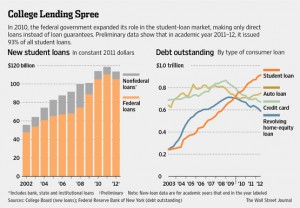 On the campaign trail, the President bragged about providing federal funding for more students to go to college. The problem is, it looks now like maybe some of those students should not have taken advantage of that funding.
On the campaign trail, the President bragged about providing federal funding for more students to go to college. The problem is, it looks now like maybe some of those students should not have taken advantage of that funding.
Since the government “removed the middle man,” as President Obama put it, it seems the lending requirements have been lowered. Student loan debt has increased to nearly a trillion dollars (yes, trillion with a “T”) and delinquencies are rising. Over 10 percent of balances are now over 90 days behind.
An article on WSJ.com quotes Senator Bob Corker from TN as asking about how the government is going to fair in this situation.
He is asking the wrong question.
The question should be, how will the students fair and what will be the long term impact on the U.S. economy?
If graduates (and some drop outs) are burdened by student debt, they enter the work force (hopefully) with a ball and chain the equivalent of a new home mortgage… just without any collateral or a place to live.
If graduates are spending decades paying off large loans, that means they are not buying cars and homes – key spending milestones that drive the economy. It may also mean putting off some other life decisions, such as starting a family, in order to right their financial ship first.
How Much is Too Much?
Let’s take it back down to the student perspective. For most families, the “estimated family contribution” calculation (aka, EFC) is a bit of a joke and it is well-known that student loans make up the difference for vast majority of families.
The government’s Parent Plus program was put in place to help cover the cost. The problem is, many parents are supposed to be saving for retirement during and after their child’s college education. What happens when Jr graduates and mom and dad owe six figures in addition to Jr’s student loans? So much for building the nest egg.
Raising the Bar
We’re facing a “school debt cliff” and the time is now to make the necessary changes.
The government needs to raise the bar and make sure that families that take on the debt can truly afford to do so. Schools need to look at family situations and do everything in their power to help families with need based grants.
And, perhaps most importantly, families need to take a step back to fully understand the decision they are making. It could possibly be the most important financial decision of their lives.
